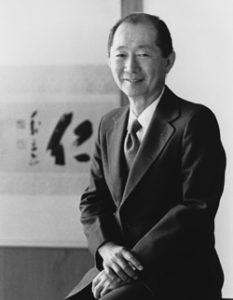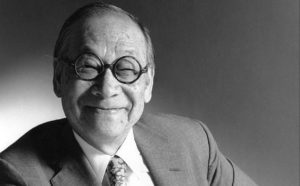As Asian American Pacific Islander (AAPI) Heritage month comes to an end, we would like to pay tribute to the those who have made a great contribution to America’s architectural history. The month of May celebrates two significant milestones for the AAPI community: the first Japanese immigrants that set foot in America on May 7, 1843 and the completion of the transcontinental railroad on May 10, 1869 through the efforts of thousands Chinese workers. Throughout the years, Asian/Pacific Americans continue to make a great impact in the workforce by designing remarkable buildings that are still be celebrated today.
Take a deeper dive into the most influential AAPI architects:
Minoru Yamasaki, FAIA (1912-1986)

“My premise is that delight and reflection are ingredients which must be added…sunlight and shadow, form, ornament, the element of surprise are little-explored fields.”
Born in Seattle, Washington, Minoru Yamasaki, was a first generation Japanese American and one of the most distinguished architects of the 20th century. During his architecture studies at University of Washington, Yamasaki worked long hours at an Alaskan cannery to make ends meet. Once he completed his undergraduate schooling in 1934, Yamasaki moved to New York to continue his passion for architecture and began his master’s degree at New York University. Following his degree, he began practicing with the designers of the Empire State Building. In 1945, Yamasaki was offered the Chief Designer position at Smith, Hinchman and Grylls in Detroit. Though soon after, he formed his own firm in 1949 becoming one of the most successful architects in the city. He became a practice leader of a New Formalist style with common features that embrace classical columns and arches, elegant details, smooth wall surfaces and designed to achieve modern monumentality post World War II. New Formalist buildings were mainly designed for banking institutions and public buildings.
Yamasaki is best known for the design on the World Trade Center, a complex consisting of several buildings including the 110-story twin towers. Not only did the towers form a distinctive feature of New York skyline, but it was also the tallest buildings at the time. Another outstanding project included the widely admired McGregor Memorial Conference Community Center in Detroit with its interior and exterior design to reflect the feeling of delight, serenity and surprise. Yamasaki designed the space to “create a structure that is in harmony with both man and its environment.” Other notable projects include Reynolds Metals Company Building, Detroit; Lambert Airport, St. Louis; and the Northwestern National Life Building, Minneapolis.
Yamasaki won the American Institute of Architects (AIA) First Honor Award three times.
Ieoh Ming Pei, FAIA, RIBA (1917 – 2019)

Ieoh Ming (I.M.) Pei, a Chinese American, best known for his modern architecture that incorporates geometry to develop clean and sharp-edge designs that will stand the test of time. In 1935, Pei moved to the United States from Guangzhou, China to start his undergraduate study in architecture at the University of Pennsylvania then transferred to Massachusetts Institute of Technology shortly after to complete his bachelor’s degree. Yearning to learn more, he furthered his education at Harvard Graduate School of Design. During his time in school, he came to the realization that his love for modern form meant more than the historic and Beaux-Arts style taught in school. By 1955, Pei established an independent design firm, I.M. Pei & Associates, where he executed a majority projects of his early work for a New York City real estate entrepreneur, William Zeckendorf.
Some of the notable projects in the United States include the National Center for Atmospheric Research, Boulder; Everson Museum of Art, Syracuse; John F. Kennedy Presidential Library and Museum, Boston; Rock and Roll Hall of Fame, Cleveland; and the East Building of the National Gallery of Art, Washington D.C. His most iconic work remains in Paris, serving as the entrance of The Louvre with its glass and metal form creating a pyramid providing a harmonious integration between the modern building and the rest of its historic surroundings.
Awards: Royal Gold Medal, AIA Gold Medal, Presidential Medal of Freedom, Pritzker Prize, Praemium Imperiale, National Design Lifetime Achievement
Lisa Iwamoto (1963 – Present)

Lisa Iwamoto is a Japanese American taking the high-tech workplace by storm with her innovative design. She began her studies at University of Colorado achieving a degree in structural engineer and a Master of Architecture degree from Harvard University. Iwamoto is an architecture professor at University of California, Berkeley teaching design studios and seminars. Iwamoto’s focuses on digital fabrication and technologies. She is also a practice co-founder of IwamotoScott alongside her husband in San Francisco. Iwamoto’s prolific designs are well known nationally including Pinterest NYC, and Twitch HQ.
Awards: California Council of the AIA Emerging Talent, Architectural League of NY Young Architects Award, AIA awards for various projects within the San Francisco, Boston and New Jersey chapters.
Carlos Arnaiz
A prestigious educator, writer and award winning design architect, Carlos Arnaiz is the founder of CAZA Architect. Arnaiz was born in the Philippines with a Columbian mother and Chinese/Filipino father. He began his studies at Williams College in literature and furthered his education at Harvard Graduate School of Design. CAZA architects is currently located in Brooklyn, NY with satellite offices in the Philippines and Columbia. Although most of his work focuses on large scaled mixed-use complexes and sustainability plans outside of the United States, Arnaiz teaches every semester at Pratt Institute in Brooklyn where he makes an impact on students learning. Some of his notable work includes the Hue Hotel.
Awards: AIANY Building Merit Award and two Progressive Architecture Awards.
Written by: Jackie Williams
References:
https://www.nytimes.com/2019/05/16/obituaries/im-pei-dead.html
https://www.britannica.com/biography/I-M-Pei
https://historicdetroit.org/buildings/mcgregor-memorial-conference-center
https://www.architectmagazine.com/practice/next-progressives-caza_o
https://www.pratt.edu/faculty_and_staff/bio/?id=rarnaiz
https://iwamotoscott.com/about
https://www.interiordesign.net/hof/2018/lisa-iwamoto-and-craig-scott/2/




